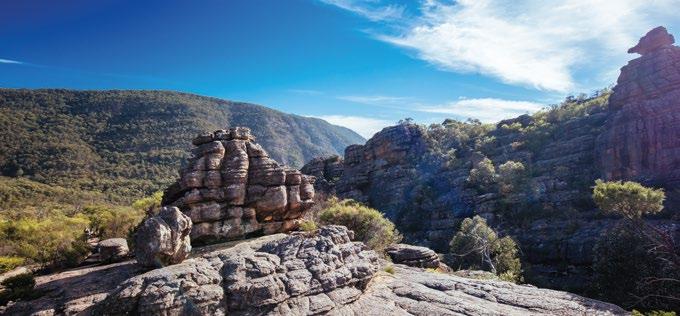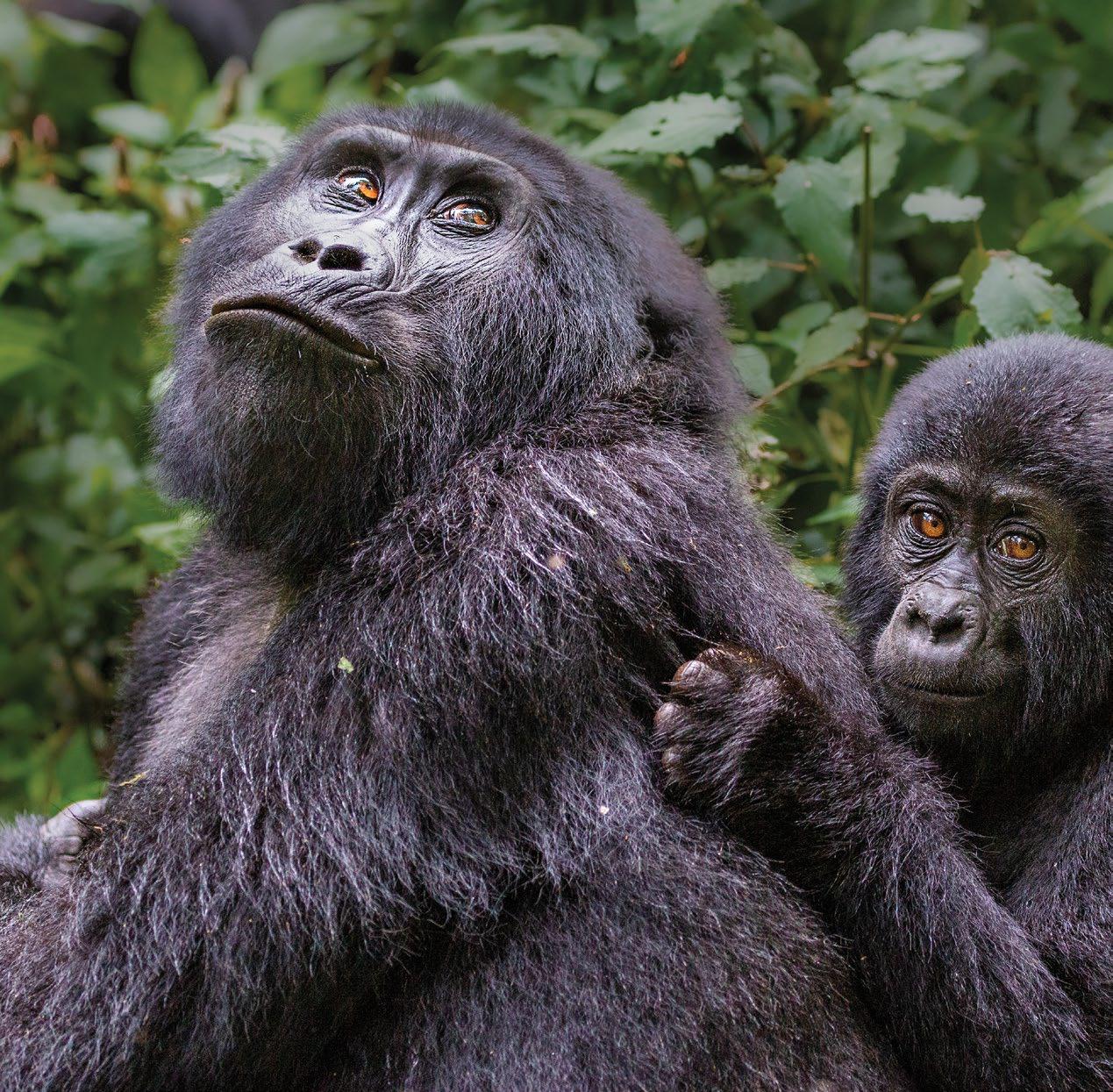
7 minute read
Australasia
Experience Australasia
Surf lessons on Australia’s beaches, a train across the rusty Outback, volcanic hikes in New Zealand...
Advertisement
Australia’s Outback Southeast Australia self-drive New Zealand’s North Island


On this 12-day trip suggestion, you’ll travel from north to south across the Australian Outback in comfort aboard The Ghan train, pausing en route to explore remote towns and fly out to Uluru. Either side, spend time in the cities of Darwin and Adelaide. Coastal drives along wave-lashed clifftops, hikes that lead to waterfalls and ancient rock art, and time to relax or surf on golden sands: this 18-day trip idea shows you the best of Australia’s southeastern corner, taking in three key cities as you go. You’ll have time to explore the North Island in depth on this 16-day suggested road trip. Steeped in Māori culture and alive with volcanic landscapes, the island is also home to black- and white-sand beaches and striking coastal drives.
Days
1-3 Explore Darwin and tour surrounding wetlands by float plane and fan boat, spotting saltwater crocodiles.
4-6 Fly out to a working cattle station to try activities like fishing, horse riding and cattle mustering.
7 Return to Darwin and enjoy a final evening in the city.
8-10 Spend three days journeying across the heart of Australia aboard The Ghan train. En route, you could fly out to Uluru, take a cruise through the Nitmiluk Gorge and tour a historic opal-mining town.
11-12 Explore Adelaide, enjoying the greenery of its parks, its alfresco restaurants and its Aboriginal art galleries.
Days
1-2 Explore Adelaide’s markets and beaches.
3-4 Enjoy wine tasting in the Barossa Valley.
5-6 Look out for ancient rock art while hiking in the Grampians National Park.
7 Hop between Port Fairy’s art galleries.
8-9 Drive the Great Ocean Road to Apollo Bay, passing the 12 Apostles sea stacks.
10-12 Drive along the coast to Melbourne and explore the city’s sights on a walking tour.
13-14 Fly to Sydney. Join a surfing lesson on Bondi Beach and stroll the Rocks District.
15-16 Go walking in the Blue Mountains, independently and with a local guide.
17-18 End your trip seeing a performance at the Sydney Opera House.
Days
1-2 Tour Auckland and its surroundings with a private Māori guide.
3-4 Visit the Coromandel Peninsula’s Hot Water Beach and discover hidden coves.
5-6 Follow the coast round to Whakatāne and stroll its beaches and ancient forests.
7-8 Browse Gisborne’s Māori museums and try surfing from white-sand beaches.
9-10 Tour Hawke’s Bay’s vineyards and explore Napier’s Art-Deco buildings with a guide.
11-12 Walk through the steaming volcanic landscape of Tongariro National Park.
13-14 Hike the slopes of Mount Taranaki or relax on New Plymouth’s beaches.
15-16 See Waitomo’s glowworm caves by boat, then return to Auckland for your flight.
From £6,980 per person* From £4,425 per person* From £4,160 per person*

Wolves in Yellowstone National Park
8 OF THE BEST
Wildlife experiences
Nothing awakens your senses like a stand-out wildlife encounter, or even the build up to it. Whether you’re trekking through rainforest in search of primates, each crack of a twig and rustle of a branch setting your heart racing, or crossing the African savannah as your eyes scan the horizon for a particular animal, you’re completely present in that moment. There are countless ways to feel closer to the natural world, but here we’ve rounded up eight wildlife experiences you’ll continue to recount long after you’ve returned home.
1Africa’s Great Migration by hot-air balloon 2 3 4
Wolf tracking in Yellowstone National Park, USA
The Great Migration sees some 1.5 million wildebeest move in a constant circuit between Kenya’s Masai Mara and Tanzania’s Serengeti. The herds follow the rains in roughly the same pattern each year, their presence attracting the attention of hungry predators. While you can see the action on game drives, a hot-air balloon flight gives you a better sense of the migration’s scale.
You’ll rise into the sky just as the sun does, the plains below bathed in a buttery-yellow glow. Dawn is when many animals are at their most active, and you’ll see wildebeest, zebra and antelope grazing in hundreds-strong herds. Unmistakable grey lumps indicate elephant clustered around waterholes, and you might see big cats setting up a morning hunt. You’ll be welcomed back to earth with a Champagne breakfast set up in the bush. While the southern half of Yellowstone is known for its steaming geysers and bubbling mudpots, the north is where you’ll have the best chance of seeing the park’s wildlife, most notably, wolves. You can join a wolf-tracking tour with an experienced naturalist guide who knows this area like the back of their hand.
You set off before dawn, arriving in the Lamar Valley as the rising sun shines its first golden rays across the landscape. Your guide will set you up with binoculars and telescopes and talk you through what you’re seeing. Large herds of bison will already be up and grazing, their breath steaming in the crisp air, alongside pronghorns and elk. But, nothing beats the sight of a wolf pack running across the ridgeline, rolling around in play or howling into the wind.
Rainforest walking in Borneo’s New Zealand kiwi encounter Danum Valley Flightless, rotund and almost fluffy in Travel through Borneo and you might notice that appearance, it’s sometimes easy to forget kiwis the Danum Valley is a popular topic of conversation. Everyone — New Zealand’s national bird — are birds at all. Notoriously who’s been lucky enough to visit can’t stop talking about elusive, they’re difficult to spot in the wild, and not just it. Those who haven’t lap up stories of rare pygmy elephant because their numbers are in drastic decline: they’re also sightings, flying squirrel encounters and the holy grail of nocturnal. Borneo’s wildlife experiences, seeing a wild orangutan. But, stay on tiny Kapiti Island, which lies just off North Set in an area of pristine primary rainforest, there’s just one Island’s west coast, and you can take a night-time tour with lodge to stay in: Borneo Rainforest Lodge, a cluster of spacious expert guides who know the best places to encounter kiwis riverside chalets. The surrounding undulating topography is rummaging in the undergrowth. After settling into your latticed with jungle trails, with viewpoints to look right over the safari-style tent, you’ll sit down to dinner as your guides go forest canopy below. The wildlife has a vast area to roam, so this over the evening’s plans, sharing tips on how to spot some of isn’t about crossing off a list of species. Instead, with a wildlife the island’s 1,200 resident kiwis. You’ll then head out into the expert to guide you, it’s about finding yourself in a remote spot night, your senses on alert as you listen out for telltale signs of of deep jungle, making brief eye contact with a wild orangutan kiwis’ presence, hopefully returning to your tent triumphant. that might not glimpse humans again for weeks or months.
Polar bear in the Arctic 5 Polar bear encounters in the Arctic Seeking out wildlife in the Arctic can feel particularly intrepid. On an expedition cruise to the Svalbard archipelago, schedules are tied to the whims of the weather, but, this inherent flexibility also allows the expedition leader to divert to see any wildlife in the locality. You won’t know exactly when you might see a polar bear, but Svalbard has the highest concentration of them in the Arctic, so your chances are good. When a bear is sighted, be prepared to quickly hop into a Zodiac (a motor-powered dinghy) to get a better look. Appearing warm-cream in the white glow of the snow, they’re easy to spot as they pad across the ice. You might even be woken at night if there’s a bear close enough to view from the ship, the sun often dipped low on the horizon casting an eerie half-light.


7Gorilla habituation in Uganda Hiking through Uganda’s Bwindi Impenetrable Forest, the trees clear to reveal a scene few others have witnessed, and one that remains under serious threat: a troop of mountain gorillas. Some sit munching on leaves in pensive silence. Younger ones squabble as they tumble through the branches. And the large silverback lazes, stretched out, in the dappled sunlight. We can arrange for you to be right there, just a few steps away. In the southern Rushaga area of Bwindi, you can help one of two gorilla troops become accustomed to non-invasive human presence, ensuring conservation work to save the species can continue. In a group of no more than four people, you’ll receive a briefing from the research team, who’ll then lead you into the forest. Steep ascents, tangled vegetation and high altitude mean the trek can be challenging, but you’re rewarded with up to four hours observing the gorillas in their natural habitat.










